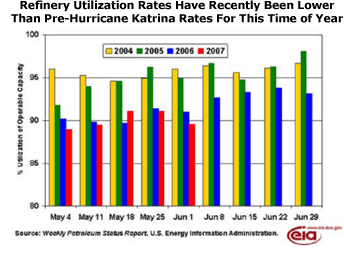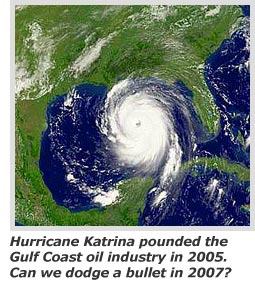Three Triggers for Higher Crude Oil Prices
Commodities / Crude Oil Jun 13, 2007 - 08:29 AM GMTSean Brodrick writes : After hitting a nine-month high last week, oil took a shellacking. I guess that means we can all breathe easier and go out and buy HUMMER H3s, right? Not so fast!
Gasoline prices are already 27 cents per gallon higher than they were a year ago, and there is plenty of evidence that they're smoking on the launch pad.
What could be the driving force behind oil's next surge? I can't be sure. That's the challenge — we never know exactly what the oil market will throw at us.
But I do see at least three potential catalysts. I'll tell you about them in a moment. And I'll also tell you how you can protect your portfolio — even profit — from the next surge in oil prices.
First, here's one major reason why it won't take much of an event to send prices soaring …
The Supply Chain from the Oil Well To Your Gas Tank Has Never Been Tighter
For 2007, the International Energy Agency sees global oil demand totaling 86.1 million barrels per day (bpd). That implies year-over-year growth in oil demand of 2%. And the world's suppliers (OPEC supplies 40% of the world's oil) are currently producing 85 million barrels per day. They can just about keep up with new demand.
More importantly, how much spare capacity is there, just in case things go wrong? (And something ALWAYS goes wrong!)
Spare petroleum capacity, according to the IEA, is capacity that can be turned on for 30 days and sustained for 90 days.
A "comfortable" level of spare global capacity would be five or six million bpd. But recently that number has been less than three million bpd. And one to two million bpd of that spare capacity is in Saudi Arabia. Talk about putting all your eggs in one basket!
Before 1970, the U.S. had spare capacity of its own … but no longer. The once-rich West Texas oil fields are now populated by thousands of stripper wells, which eke out oil by the tablespoon.
And there is always the possibility that countries which say they have spare capacity — particularly Saudi Arabia and Kuwait — may be bluffing. Why would they bluff? If your entire society depended on one commodity, would you want the world to know you were running out of that commodity?
The Dwindling Giants
Kuwait's giant Burgan oil field already peaked.
Reserves in Saudi Arabia's humongous Ghawar field, which pumps roughly five million barrels of oil every day (meeting 6% of the world's demand) are declining at 8% a year. In fact, Saudi oil production has been dropping since 2004. They say they're cutting by choice. If the product you sold was going for record prices, would you cut production?
Closer to home, Mexico's big oil field, Cantarell, peaked in 2004 at slightly over two million barrels per day. Since then, its production is down to just 1.6 million barrels per day. And in the next three years, Cantarell will produce less than half a million barrels per day, according to experts. Soon after that, Mexico will have to start importing oil.
So we're already in trouble. In fact, if you really want to start sweating, here are some things to think about:
- The world consumes 173 billion barrels of oil — about 14 Prudhoe Bays — every 2.4 years.
- Just to keep prices stable, we're going to have to find a couple more Ghawar-sized fields in less than 10 years.
- The world will consume 10% of the remaining conventional crude oil reserves before George Bush is out of office.
Now, new oil fields are being discovered. But they're often deep under the ocean … they're never really big … and they always seem to belong to somebody that is not America's best friend.
By the way, China's oil imports are rip-roaring. The country now imports 3.5 million barrels a day. However, we shouldn't point fingers. The U.S. imports 12.2 million barrels per day for a population that's less than a fourth the size of China's!
Making matters worse, the Energy Information Administration estimates that global demand for oil will reach 98 million barrels per day by 2015. Thus, even IF China and these other countries are able to develop these difficult fields, they'll probably just put that gasoline into their own tanks.
So that's the big-picture longer-term supply/demand squeeze. But you know what?
We're Also Facing A Shorter-Term Squeeze

While growth in gasoline demand has slowed somewhat, it is still rising (up 1.5% year over year). And every time gasoline prices flatten, demand surges. This should send pressure up the chain all the way back to light sweet crude, which is the easiest source of oil to use for gasoline production.
Meanwhile, refinery utilization, which normally hovers in the 95% range this time of year, is currently under 90%. Not only are refiners working at lower rates than they were before Katrina … their utilization is lower than when the refiners were still trying to recover from Hurricane Katrina.
Bottom line: Refinery utilization is now at a 15-year low.
There are plenty of reasons why refineries aren't going at full-blast, but those aren't as important as this simple equation:
Lower refinery utilization …
Plus higher gasoline demand …
Equals less gasoline in storage, and less of a cushion in the event of a shock to the system.
The Three Biggest Threats That Could Drive Oil and Gasoline Higher
Threat #1: Hurricane season is here, and it should be a whopper!

We already had two named storms by the official start of hurricane season on June 1. Experts at Colorado State University are looking for a whopping 17 named storms in the Atlantic this season, which runs from June 1 to November 30.
Plus, scientists say nine of the storms should become hurricanes, and a stunning five of those will hit major hurricane status (with sustained winds greater than 111 miles an hour)!
There's also a 74% chance that at least one major hurricane will make landfall on the U.S. coastline. The long-term average is just 52%!
Like everyone, I hope we are spared an active hurricane season. But the fact remains that even the hint of potential hurricane-related supply disruptions can send energy prices soaring.
Threat #2: Trouble in Iraq Could Ignite the Persian Gulf.
You probably know that Iraq is bordered by two of the biggest oil producing countries in the world, Saudi Arabia and Iran. Here's what you may not know:
The small-but-committed cadre of foreign al Qaeda fighters in Iraq hate the Saudi Arabian government as much as they hate Uncle Sam. They consider the Saudi royals to be enablers of the American war machine, our willing dupes in the region and defilers of sacred ground (Mecca).
Unfortunately, these terrorists are getting the best on-the-job training bin Laden could ask for by battling our troops. The question the Saudis worry about is what if those al Qaeda fighters turn their attention to Saudi soil?
There have been a few failed attempts by Islamic terrorists at blowing up Saudi oil facilities. If al Qaeda puts energy and commitment into toppling the Saudi monarchy, we could see a real impact on the world's "Central Bank of Oil." A lucky missile strike on Saudi oil facilities could send energy prices soaring.
Threat #3: A potential al Qaeda attack on U.S. oil facilities.
At least the oil facilities in Saudi Arabia are protected by guards, tanks, even anti-aircraft weapons! On my recent trip to Corpus Christi, Texas, I drove right past giant refinery complexes, so close I could have thrown a football and hit them.
I'm sure that U.S. refineries and oil terminals have ratcheted up security since 9/11. But if you've ever seen these big complexes in Texas and Louisiana — not far out in the desert as in Saudi Arabia, but close to U.S. population centers — you know that all it takes is one kook with a rocket launcher or some stolen explosives to do some serious damage. And 350 tons of super-high explosives went missing after we invaded Iraq!
And for Pete's sake, the southern U.S. border is so porous you can smuggle in anything any terrorist could want. We can only hope that Homeland Security keeps up with the crazies!
How to Protect Yourself, And Potentially Profit, From Rising Gas Prices
Naturally, energy stocks that are leveraged to the price of oil should do well the next time oil prices surge. That's why I love finding smaller, underloved oil and gas stocks that are packed with potential.
Interestingly enough, the best ones tend to be overseas. I'm looking at some of those stocks right now for my Red-Hot Global Small-Caps service. You can find them on your own, too — just make sure you do your due diligence.
If you don't like the potential volatility of small-caps (or even individual stocks), you can also consider a good ETF like the Energy Select SPDR (XLE) .
Of course, 33% of the XLE is in two stocks, ExxonMobil and Chevron. For more diversity, you might want to check out a mutual fund like U.S. Global Investors Global Resources Fund (PSPFX) . This no-load fund's holdings are more spread out through the energy complex, with top holdings Schlumberger, Noble Corp. and White Nile each taking up less than 3% of the total.
But whatever you do, get ready for a wild ride in energy prices this summer!
Yours for trading profits,
By Sean Brodrick
This investment news is brought to you by Money and Markets . Money and Markets is a free daily investment newsletter from Martin D. Weiss and Weiss Research analysts offering the latest investing news and financial insights for the stock market, including tips and advice on investing in gold, energy and oil. Dr. Weiss is a leader in the fields of investing, interest rates, financial safety and economic forecasting. To view archives or subscribe, visit http://www.moneyandmarkets.com .
Money and Markets Archive |
© 2005-2022 http://www.MarketOracle.co.uk - The Market Oracle is a FREE Daily Financial Markets Analysis & Forecasting online publication.



